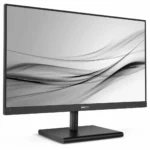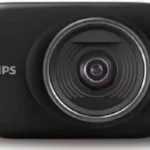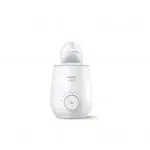
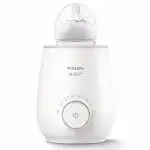
PHILIPS SCF355 Avent Fast Bottle Warmer

PHILIPS SCF355 Avent Fast Bottle Warmer
Important
- Read this user manual carefully before you use the bottle warmer and save it for future reference.
Danger
- Do not immerse the cord, plug, or appliance in water or other liquid.
Warning
– Only use the appliance indoors.
– Do not let the main cord hang over the edge of a table or worktop.
The excess cord can be stored in the base of the bottle warmer.
– Keep the main cord away from hot surfaces.
– Only connect the appliance to an earthed wall socket. Always make sure that the plug is inserted into the wall socket properly.
– Check if the voltage indicated on the bottom of the appliance corresponds to the local mains voltage before you connect the appliance.
– If you need to use an extension cord, make sure it is an earthed extension cord with a rating of at least 13 amperes.
– Do not use the appliance if the plug, the mains cord, or the appliance itself is damaged. If the main cord is damaged, you must have it replaced by Philips, a service center authorised by Philips, or similarly qualified persons in order to avoid a hazard.
– Do not place the appliance on or near a hot gas or electric cooker, or in a heated oven.
– These appliances can be used by persons with reduced physical, sensory or mental capabilities or lack of experience and knowledge if they have been given supervision or instruction concerning the use of the appliance in a safe way and understand the hazards involved.
– Cleaning and user maintenance shall not be made by children.
– This appliance shall not be used by children. Keep the appliance and its cord out of reach of children.
– Children shall not play with the appliance.
– Do not spill water on the mains plug.
– Only use the appliance as described in the user manual to avoid potential injury due to misuse.
– Do not preheat the appliance.
– Always place a fully assembled bottle with cap in the bottle warmer before you add water.
– Make sure you add water before you switch on the bottle warmer.
– Hot water can cause serious burns. Be careful when the bottle warmer contains hot water.
– The accessible surfaces of the appliance may become hot during use and are subject to residual heat after use.
– Do not move the appliance when it contains hot water.
– When the food or milk has reached the required temperature, remove the bottle or container from the bottle warmer. If you leave food or milk in the bottle warmer, the temperature of the food or milk increases.
– Always check the food temperature before you feed your child.
Gently swirl the bottle and check by sprinkling a few drops on the inside of your wrist.
Caution
– This appliance is intended to be used in household and similar applications such as farmhouses, bed and breakfast type environments, staff kitchen areas in shops, offices, and other working environments, and by clients in hotels, motels, and other residential type environments.
– Unplug the appliance when it is not in use.
– The surface of the heating element is subject to residual heat after use.
– Let the appliance cool down before you clean it.
– Follow the descaling instructions to avoid irreparable damage.
– Do not try to open or repair the appliance yourself. You can contact the Philips Consumer Care Center in your country (see www.philips.com/support).
– The food should not be heated for too long.
The production date code YYWW is located in the cord storage compartment in the base of the bottle warmer.
Electromagnetic fields (EMF)
This Philips appliance complies with all applicable standards and regulations regarding exposure to electromagnetic fields.
Introduction
Congratulations on your purchase and welcome to Philips Avent! To fully benefit from the support that Philips Avent offers, register your product at www.philips.com/welcome.
With this bottle warmer, you can safely warm all Philips Avent feeding bottles and milk/baby food in containers and other baby food jars.
Note: Philips Avent breast milk bags and Philips Avent 2 oz/60 ml bottles cannot be used in this bottle warmer.
Using the bottle warmer
Product overview

Explanation of settings
 |
The bottle warmer is switched off and the light is off. In every other setting, the appliance is switched on and the light is lit. |
 |
Select this setting when you want to quickly warm a bottle of milk at the room temperature (22 °C/72 °F) with content from 60 ml/2 oz to 330 ml/11 oz or at cold temperature (5 °C/40 °F) with content from 60 ml/2 oz to 240 ml/8 oz. The bottle has to be taken out immediately after warming to the right temperature, otherwise, the milk will be overheated. |
 |
Select this setting when you want to quickly warm a bottle of milk at a cold temperature (5° C/40 °F) with a content from 270 ml/9 oz to 330 ml/11 oz. The bottle has to be taken out immediately after warming to the right temperature, otherwise, the milk will be overheated. |
 |
Select this setting when you want to warm a container/jar of baby food. |
 |
This setting warms milk at a slower speed and then keeps it warm. |
 |
Defrost a bottle/container of milk/baby food to a liquid state. No Warming occurs. |
Use the bottle warmer with express milk warming setting
- Put the mains plug in the wall socket. Place a bottle in the bottle warmer.

- Fill the bottle warmer with drinking water up to the level of the milk in the bottle. In the case of large amounts of milk, the maximum level of water is approximately 1 cm below the top of the bottle warmer. An accurate water level ensures correct warming performance.

- Select the desired setting based on the milk volume. See the express warming reference table at the end of this chapter to check how long the milk needs to be warmed in the selected setting.

 Note
Note
• The speed of warming milk depends on the amount of the milk warmed and on its initial temperature, i.e. room temperature (22 °C) or fridge temperature (5 °C). - The orange light goes on when you select a setting. This indicates that the bottle warmer is on.

 Note
Note
• Whilst warming the milk circulates and heats evenly. - Check the express warming reference table for the time required to warm the milk. After the time indicated in the express warming reference table has passed, remove the bottle for feeding or turn the knob to “Keep Warm” to keep milk warm at the right temperature.

 Tip
Tip
• When you find the milk is not warm enough, you can place the bottle back into the appliance for a maximum of 30 seconds of extra warming. This will create a slightly warmer result but without overheating.
 Caution
Caution
• If you leave the bottle in the bottle warmer longer than the time indicated in the settings table, the milk may become overheated.
• If you overheat breast milk, valuable nutrients and vitamins may be lost. - Always check the temperature before you feed your baby. Gently shake the bottle or milk storage container and check the temperature of the milk by sprinkling a few drops on the inside of your wrist.

- Turn the knob back to the ‘off’ position.

 Caution
Caution
• The water in the bottle warmer might be hot after finishing warming milk/baby food. Be careful that hot water can cause serious burns.
• If you do not turn the knob back to the ‘off’ position, the water keeps heating up and will reach a very high temperature.
Express warming reference table
| ml/oz |  |
 |
|
| 22°C/72°F | 5°C/40°F | 5°C/40°F | |
| min | min | min | |
| 60 ml/2 oz – <150 ml/5 oz | 3-Feb | 6-May | – |
| 150 ml/5 oz – <210 ml/7 oz | 4-Mar | 7-Jun | – |
| 210 ml/7 oz – <270 ml/9 oz | 5-Apr | 9-Jul | – |
| 270 ml/9 oz – 330 ml/11 oz | 6-May | – | 10-Aug |
 Note
Note
- Indicated warming times are based on Philips Avent Natural and Classic+ polypropylene bottles. Be aware that warming times of Philips Avent Anti-colic with AirFree vent polypropylene bottles and Natural glass bottles deviate from these indications. In addition to bottle type and material, characteristics like thickness may also impact warming time. Therefore it may take less time to warm a larger volume of milk.
- The milk may feel cool to you, but for a newborn baby, its temperature is very pleasant.
Using the bottle warmer to warm baby food
- Follow the same steps as indicated in the previous chapter.
- Make sure to stir the baby food during warming as it does not circulate automatically. Be careful not to burn your fingers when holding the container/jar while stirring.

After warming test the baby food with a spoon to ensure it is not too hot. If the baby food is not warm enough, put the container back into the bottle warmer and warm the baby food until it has the desired temperature.
 Note
Note
- Due to the high variety of baby food consistencies, it is strongly recommended to continuously stir and check while you are warming the baby food for an optimal result.
- Due to the high variety of baby food consistencies, it is not possible to indicate warming timings for baby food.
Using the keep warm setting to warm milk
- Put the mains plug in the wall socket. Place the bottle or container in the bottle warmer.
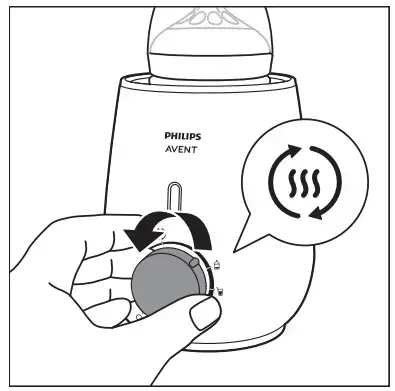
- Fill the bottle warmer with drinking water up to the level of the milk in the bottle/container.
In the case of large amounts of milk, the maximum level of water is approximately 1 cm below the top of the bottle warmer.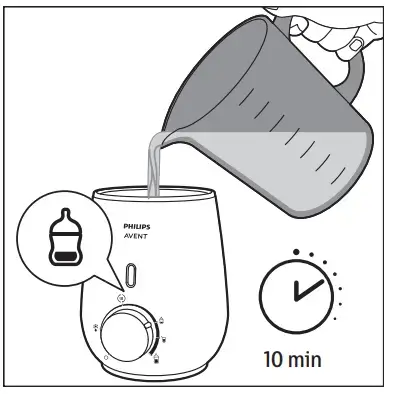
- Select the position of keeping warm.
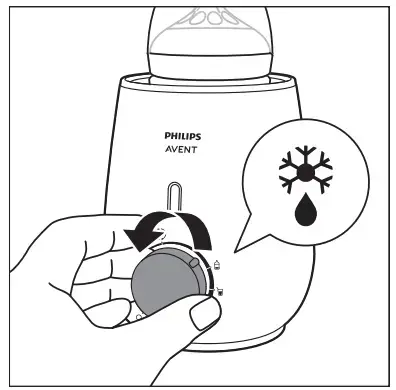 In this setting, you can warm your milk at a slow pace and keep it warm at the right end temperature. E.g. to warm a bottle of 4 oz milk starting from room temperature, it will take 15-20 minutes. The warming time may be longer or shorter depending on the milk volumes and starting temperature.
In this setting, you can warm your milk at a slow pace and keep it warm at the right end temperature. E.g. to warm a bottle of 4 oz milk starting from room temperature, it will take 15-20 minutes. The warming time may be longer or shorter depending on the milk volumes and starting temperature.
 Note
Note
• Philips Avent recommends you feed your baby as soon as possible after the milk is warmed. We advise not to reheat the milk after it has cooled down again.
• Always check the temperature before you feed your baby. - Turn the knob back to the ‘off’ position when the bottle/container is removed from the bottle warmer.

Use the bottle warmer with defrost setting
- Put the appliance plug in the wall outlet. Place the bottle or container in the bottle warmer.
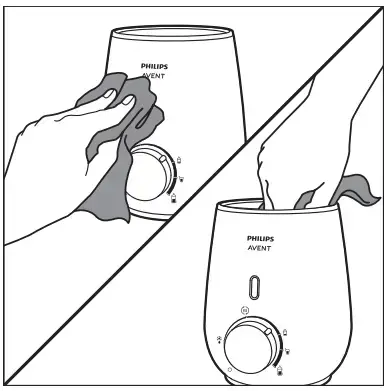
- Fill the bottle warmer with drinking water up to the level of the milk/baby food in the bottle/container. In the case of large amounts of milk/baby food, the maximum level of water is approximately 1 cm below the top of the bottle warmer.

- Select the position of defrosting.

In this setting, your frozen milk/baby food can be defrosted to a liquid state.
For frozen milk, check the warming reference table for the expected defrost timings. After your milk is defrosted, choose the express warming setting or keep the warm setting to warm your milk. Please refer to the previous chapters for usage instructions. Consider the start temperature of your milk around fridge temperature for the warming timings as a rough guideline.
ml/oz hours 60 ml/2 oz-90 ml/3 oz 1-1.5 120 ml/4 oz-150 ml/5 oz 1.5-2 180 ml/6 oz-210 ml/7 oz 1.5-2.5 - You may also defrost baby food in a Philips Avent food container with this setting. After your baby food is defrosted, choose a food warming setting to warm it. Please refer to the previous chapter for usage instructions.
 Note
Note
- Due to the high variety of baby food consistencies, it is strongly recommended to continuously stir and check while you are warming the baby food for an optimal result.
- Due to the high variety of baby food consistencies, it is not possible to indicate warming timings for baby food.
Cleaning and descaling
Cleaning
- After each use, unplug the bottle warmer and let it cool down.
- Remove the water from the bottle warmer for hygienic reasons.

- Wipe the outside and inside of the bottle warmer with a moist cloth.
» Do not use abrasive, antibacterial cleaning agents, chemical solvents, or sharp tools to clean the bottle warmer.

 Note
Note
- If you used the bottle warmer to warm baby food, make sure that no spilled baby food remains at the bottom of the bottle warmer.
Descaling
It is recommended to descale the bottle warmer every four weeks to ensure it works efficiently.
- Mix 50 ml/1.7 oz of white vinegar with 100 ml/3.4 oz of cold water to descale the bottle warmer. Switch on the bottle warmer, select the express milk warming setting 1 and let the appliance operate for 10 minutes. Leave the solution in the bottle warmer until all scale has dissolved.

 Note
Note
• You can also use citric acid-based descalers.
• Do not use other types of descalers. - Unplug the bottle warmer before you empty it.

- Empty the bottle warmer and rinse its inside thoroughly. If you still see traces of scale after rinsing, repeat the descaling procedure.

Recycling
Do not throw away the product with the normal household waste at the end of its life, but hand it in at an official collection point for recycling. By doing this, you help to preserve the environment.
Follow your country’s rules for the separate collection of electrical and electronic products. Correct disposal helps prevent negative consequences for the environment and human health.
Guarantee and support
If you need information or support, please visit www.philips.com/support or read the separate worldwide guarantee leaflet.
Troubleshooting
This chapter summarizes the most common problems you could encounter with the appliance.
If you are unable to resolve the problem with the information below, contact the Consumer Care Center in your country.
| Problem | Solution |
| The milk is too hot. | You may have selected an incorrect setting or have left the bottle in the bottle warmer longer than the time indicated in the settings table. Select the setting and check the time required to warm the milk according to the “Express warming reference table”. After the time indicated in the express warming reference table has passed, take out the bottle immediately or turn the knob to “Keep Warm” to keep the milk warm, otherwise, the milk will be overheated. |
| The milk is still cold. | You may have selected an incorrect setting or have used a silicone bottle. Select the setting and check the time required to warm the milk according to the “Express warming reference table”. After the time indicated in the express warming reference table has passed, take out the bottle immediately or turn the knob to “Keep Warm” to keep the milk warm, otherwise, the milk will be overheated. If you are using a silicone bottle, after the time indicated in the express warming reference table has passed, wait for 30-60 seconds to ensure the milk is warm. |
| The bottle warmer defrosts milk too slowly. | The milk should never be defrosted at a high temperature because it will lead to a loss of nutrients. Due to the gentle temperature at which the milk is being defrosted, it might take a longer time than expected to melt the milk. |
| The bottle warmer stops working during the warming process. I cannot turn on the bottle warmer. |
The bottom of the bottle warmer may be blocked by the limescale. The bottle warmer should be descaled at least every four weeks. See section “Descaling”. |
Specifications are subject to change without notice
© 2020 Koninklijke Philips N.V.
All rights reserved.
3000 057 83541
DOWNLOAD RESOURCES
- PHILIPS SCF355 Avent Fast Bottle Warmer [pdf] User Manual SCF355, Avent Fast Bottle Warmer, SCF355 Avent Fast Bottle Warmer
- Read more: https://manuals.plus/philips/scf355-avent-fast-bottle-warmer-manual#ixzz7iDbC409I
FAQ’S
Can I use the bottle warmer in the microwave?
No, do not use the bottle warmer in the microwave.
Can I use the bottle warmer on a gas or electric cooker?
No, do not use the bottle warmer on a gas or electric cooker.
How long does it take to warm a baby’s bottle?
It takes approximately 3 minutes to warm a baby’s bottle. However, this may vary depending on the type of baby’s bottle and how cold it is.
Can I warm bottles that are not made of glass?
Yes, you can warm bottles that are made of plastic and silicone. However, you should check whether these bottles are suitable for warming in a microwave oven before you put them into the bottle warmer. Plastic bottles should be BPA-free. Silicone bottles should be heat-resistant to temperatures of at least 120°C and should have a maximum temperature tolerance of -50°C to +230°C. If you have any doubts about whether your plastic or silicone baby’s bottles are suitable for warming in a microwave oven, please contact Philips Consumer Care.
Do you put water in Avent bottle warmer?
For 125ml/4oz bottles, fill the warmer with water to just above the level of the milk in the bottle. For 260ml/9oz bottle, fill the warmer to 15 mm (1/2 inch) below the rim of the warmer. Never let water level rise above the neck of the bottle or spill over the edge of the warmer.
How often should I sterilize baby bottles?
For extra germ removal, sanitize feeding items at least once daily. Sanitizing is particularly important when your baby is younger than 2 months, was born prematurely, or has a weakened immune system.
What are the settings on the Philips Avent bottle warmer?
You can set from 30 ml / 1 oz up to 330 ml / 11 oz. The bottle warmer warms the milk to approximately body temperature. It then goes to keep warm mode automatically for about 60 minutes.
What temp does Avent bottle warmer warm to?
The AVENT heats slowly and fails to reach room temperature following the instructions with average temps of only 63F. Overall, it isn’t the worst warmer in our tests, but Fast is not a word we’d used to describe this warmer.
Do bottle warmers turn off automatically?
Keeps milk warm for up to 60min and automatically shuts off
Our bottle warmer keeps milk warm for up to 60 minutes, just in case you need more flexibility around mealtime. Then automatically shuts off, giving you peace of mind.
How do I know when Avent bottle warmer is done?
The bottle warmer switches off automatically after about 60 minutes, including defrosting and warming time. The progress indicator turns off. You can also defrost baby food in the Philips Avent food container with this setting.
How does a baby bottle warmer work?
How does a baby bottle warmer work? Traditional baby bottle warmers have a central vessel where you put your baby’s bottle in. You then fill around the bottle with water and switch on the power, which enables the heating element in the bottle warmer to heat the water and bottled milk in turn.
How long can breast milk stay in bottle warmer?
But as a general rule breast milk is good in a bottle warmer for: a maximum of four hours for fresh breast milk. After four hours you should use, store, or discard it. for two hours if your breastmilk has been previously stored and thawed.
VIDEO


PHILIPS SCF355 Avent Fast Bottle Warmer
www://philips.co.uk/
